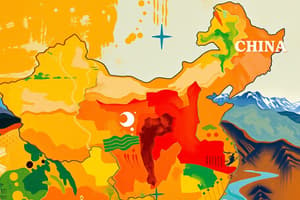Podcast
Questions and Answers
What was the nature of the relationship between China and the Soviet Union
What was the nature of the relationship between China and the Soviet Union
1949 - Chinese Communist Party (CCP) beats the Nationalists under Chiang Kai Shek - establishment of the People's Republic of China (PRC) in October 1949
- Stalin supports the PRC - sees USSR as dominant partner
- Treaty of Friendship signed in 1950 when Mao visits Moscow - aligned by common enemy of the USA/the West
- USSR sends aid and equipment to the PRC
- Stalin demands PRC armed forces to be at Soviet disposal • Mao begins the establishment of a Marxist state
- creation of a one-party system - PRC similar to USSR ideologically in late 1940s - but Mao begins to focus more on transformation in rural areas - different to Marxism-Leninism which focused on urban workers
- evidence of disagreements from mid-1950s
- modernisation of industry through five-year plans - Soviet technicians/engineers sent to China to assist with infrastructure projects
How did Chairman Mao and Premier Khrushchev change the relationship between China and the Soviet Union?
How did Chairman Mao and Premier Khrushchev change the relationship between China and the Soviet Union?
Khrushchev replaces Stalin in 1953 - begins process of 'de-Stalinisation' and establishes 'peaceful coexistence' with the West - Mao critical of Soviet 'revisionism - sees USSR moving away from principles of Lenin • USSR and PRC increasingly critical of each other ideologically and politically
- Unresolved territorial disputes along the Soviet and Chinese borders - underpins increasing diplomatic divisions
- Mao viewed Soviet aid as insufficient compared to non-Communist countries
- USSR disparaging of Mao's 'Great Leap Forward' - ideological shifts evident USSR refused to supply PRC with nuclear technology/weapons
- Soviets and Chinese compete for influence in the newly independent states in Africa and Asia - Eastern Bloc states also split over support for USSR and PRC
- Mao embarrasses Khruschev personally with images of Soviet leader swimming with water wings - increases mutual antipathy of leaders - leads to increasingly personal rivalry.
What was the impact of the Sino-Soviet Split on the Cold War by 1973?
What was the impact of the Sino-Soviet Split on the Cold War by 1973?
Increased divisions in the 1960s:
- 1960 - USSR withdraws advisors and cancels all aid o Increases aid to Third World mave back india and are talks Parita in vegional confit, By mi. 1960s Sre-soret Spl evden ris handing of the Cuban Misile Crisis IEB Copyright © 2023 PLEASE TURN OVER NATIONAL SENIOR CERTIFICATE: HISTORY: PAPER I - MARKING GUIDELINES Page 8 of 10 • Improved relations with the USA in the late 1960s:
- PRC attitudes to USA change • USA no longer a threat in South-East Asia owing to failure in Vietnam • End of 'Cultural Revolution' in PRC changes attitudes to USA owing to purges of CPC (Communist Party of China)
- USA sees PRC as a means to undermine communist collaboration • 1971 US ping-pong team visits PRC • USA withdraws opposition to PRC's membership of United Nations - PRC takes seat on Security Council • 1972 Nixon visits China - period of détente
What were the relations between China and the USA from 1949 to 1970?
What were the relations between China and the USA from 1949 to 1970?
Flashcards are hidden until you start studying
Study Notes
Sino-Soviet Relations
- Post-World War II, China and the Soviet Union were allies, sharing a common ideological foundation in communism.
- Both countries viewed the United States as a major threat and supported communist movements globally.
- The relationship was complex, with both countries vying for leadership within the communist bloc.
Mao and Khrushchev
- Chairman Mao Zedong of China and Premier Nikita Khrushchev of the Soviet Union came to power after Stalin's death in 1953.
- Mao emphasized a more radical path of revolution, prioritizing ideological purity over economic development.
- Khrushchev adopted a more pragmatic approach, seeking to improve ties with the West and promote peaceful coexistence.
- These ideological differences, particularly regarding the path to communism, led to increasing tensions.
Sino-Soviet Split
- The Sino-Soviet split became official in the early 1960s.
- Factors contributing to the split:
- Khrushchev's de-Stalinization campaign
- The Soviet Union's focus on peaceful coexistence with the West
- China's claim to leadership within the communist bloc
- The split weakened the communist bloc and allowed the United States to pursue a more assertive foreign policy.
- The split also had implications for the Cold War, contributing to a more complex global balance of power.
China-USA Relations (1949-1970)
- The United States did not recognize the People's Republic of China (PRC) after its establishment in 1949.
- Tensions rose further during the Korean War, where the United States fought against Chinese forces.
- China and the United States engaged in a series of diplomatic maneuvers to test each other's commitments and intentions.
- By the early 1970s, both countries began to perceive advantages in establishing a relationship, partially influenced by the Sino-Soviet split.
Studying That Suits You
Use AI to generate personalized quizzes and flashcards to suit your learning preferences.



